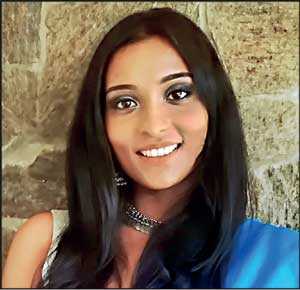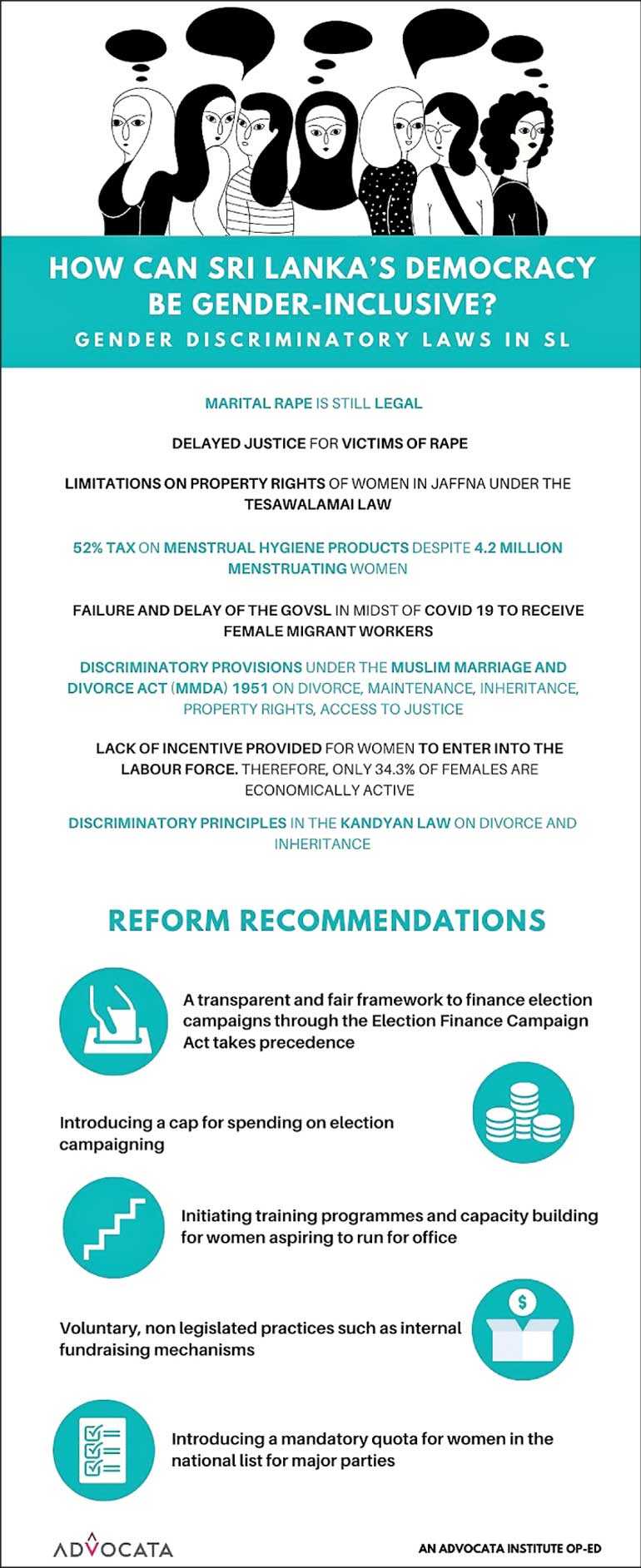Saturday Dec 20, 2025
Saturday Dec 20, 2025
Saturday, 29 August 2020 00:00 - - {{hitsCtrl.values.hits}}
 By Sathya Karunarathne
By Sathya Karunarathne
Sri Lanka’s general election dawned at a crucial time of extreme uncertainty and precariousness. The island’s political, social, and economic spheres have been dismantled by an unexpected global pandemic that drove the country into a political limbo with the dissolving of the parliament.
The task of untangling the island from its woes has now been handed over to a male-led parliament elected by the general public ostensibly upholding the true values of a democracy. In contrast, Sri Lanka’s female demographic which constitutes 52% of the population is left underrepresented in parliament, forgotten, and deprived of positions of power and access to the national decision making and policy implementation process, yet again.
At present, Sri Lanka is ranked 182 out of 193 countries on the inter-parliamentary union of rankings which assesses the percentage share of women in national government1. In the previous parliament 13 legislators, or rather a handful of 5.8% of 225 MPs represented the voice and needs of 52% of the population. Moreover, there was only one woman under the age of 40 in parliament that represented the needs of young women. The newly elected parliament boasts a grand total of one cabinet and two state female Ministers with five more female members of parliament being elected by popular vote. Moreover, SLPP, SJB, and NPP have collectively appointed four female representatives through their National Lists.
The World Gender Gap Report published by the World Economic Forum ranked Sri Lanka amongst the top 20 countries in 2006. However, Sri Lanka has drastically slipped in the rankings and has descended to be ranked 102 out of 153 countries in the year 2020 despite performing well on other indicators such as health and education. In 2006 Sri Lanka ranked 84th on the economic participation and opportunity sub index while in 2020 we ranked 126, slipping 42 places. Moreover wage equality for similar work has degraded by 27 places since 2006 from being ranked 55 to being ranked 82.
Further, Sri Lanka has performed poorly on the political empowerment sub indicator ranking 7 in 2006 and 73 in the year 2020. Even though Sri Lanka has ranked 9 on “years with a female head of state” indicator it should be noted that the index takes into consideration countries with the most years of a female head of state in the past fifty years. As this is a large time frame it does not necessarily reflect consistency in female political empowerment, especially in the Sri Lankan context.2
Why does female representation matter?
The World Economic Forum states that women are underrepresented in the political sphere globally, with women only making up 23% of national parliamentarians. This severe underrepresentation has an empirical correlation with policy choices and adverse consequences in women’s and children’s welfare. A study by the World Economic Forum addressed this issue by analysing gender representation in local municipalities and the provision of public childcare in Bavaria. To assess the effect female councillors would have on public childcare a study was carried out to compare the expansion of public childcare across municipalities that have similar characteristics but differ in their share of female councillors. Results emphasised that one additional woman in the local council accelerates the expansion of public childcare by 0.4 spots per 1,000 inhabitants or by 40%. Moreover, a comparison of over 7,700 minutes of council meetings displayed that one additional woman translates to child care being spoken of more frequently and that it creates the ambiance for other female councillors to voice their opinion confidently and to play a more active role in the process of policymaking and implementation.3
These findings are relevant to Sri Lanka now more so than ever as Sri Lanka has seen a spike in the number of child abuse and violation of child rights reported in the year, highlighting the lack of female perspective in the policymaking process.
Furthermore, Sri Lanka is no stranger to policies and laws that are excruciatingly gender discriminatory. Marital rape being legal under the penal code which dehumanises the ‘role and duty of a wife’, the Muslim Marriage and Divorce Act (MMDA) of 1951 that has a multitude of discriminatory provisions with regard to marriage, divorce, maintenance, inheritance, property rights and access to justice for Muslim women, discriminatory principles in the Kandyan law on divorce and inheritance, limitations on property rights applicable to women in Jaffna under the Tesawalamai law, mammoth taxes on menstrual hygiene products that are considered a luxury despite 4.2 million menstruating women, 14-year justice struggle for victims of rape, lack of incentive provided for women to enter into the labour force resulting in only 34.3% of females being economically active, failure and delay of the government in midst of the COVID-19 pandemic to repatriate migrant workers that mostly comprise of women who are Sri Lanka’s highest foreign exchange earners, lack of a monitory body/mechanism to assist families and children of migrant workers are just a few amongst a host of gender insensitive and discriminatory laws and policies that haunt the quality of life, day-to-day activities, and even threaten the very lives of women across the island. It takes no expert to identify that much-needed reforms have been conveniently pushed under the rug over the years due to lack of female perspective and representation in positions of power and parliament where laws and policies are debated and solidified.
Laments of local females aspiring to shatter the glass ceiling
A glance at the number of female contestants from each major party in the recent general election depicts the difficulty female expectants face in being nominated as a candidate. With the motive of addressing these issues and ensuring women representation in local government, Local Authorities Elections (Amendment) Act, No. 1 of 2016 was introduced which presented a 25% mandatory quota for women. The practicality of abruptly coercing women into positions of power was lost in this attempt. Candidates were provided with zero training and preparation to enter into local government, despite years of convincing them that their expertise lies within the boundaries of a kitchen. Moreover, the lack of preparation in this regard resulted in priority being given to relatives and close associates of politicians overlooking qualified and competent candidates.
Since Mrs. Bandaraniake’s debut, Sri Lanka’s lineage of female leaders has repeatedly painted a dramatic chronicle of the devoted woman, who steps out of their male counterpart’s shadow in the case of his demise to dutifully carry on the legacy of the deceased. This narrative does not only rob these females of an authentic career and individuality but also leaves a permanent imprint of pedigree that doesn’t necessarily reflect the aspirations of the average woman. Moreover, this phenomenon compromises the quality of leadership as overnight shifts to the political sphere has a certain degree of risk attached to it.
Women continue to be severely underrepresented due to the unequal access to finances and resources needed to successfully seek nominations and to participate in electoral campaigns. According to research conducted by UN Women in 2013, over 80% of respondents identified the lack of access to funding as one of the biggest obstacles for women to participate in a political competition (Ballington and Kahane, 2014). Politics and campaigning is a sphere dominated by big money and more often than not the economically disempowered woman is ruled out from this rich man’s club. According to Lihini Fernando, UNP’s municipal councillor from Moratuwa it costs Rs. 25 million roughly to campaign throughout the district.4 Strong female candidates such as Rosy Senanayake too have stated that financial pressure is a huge burden carried by women that are less likely to have sponsors.5 Moreover, females employed in the corporate sector, activists, legislature experts, etc. are disincentivised to enter into politics due to the high costs involved both financially and otherwise.
Psychological, sexual, and physical violence against women swamps the arena of politics. Sexually provocative comments publicly directed on new media, abuse from traditional media, the pressure to conform to a subordinate, the stereotypical image of an ideal woman, threats, and physical violence scourges the day-to-day experiences of a woman contesting to enter into government.
Reform recommendations
Despite Sri Lanka ratifying the Convention on Elimination of All Forms of Discrimination Against Women (CEDAW) and enshrined its commitment in the Women’s Charter of Sri Lanka (1993) and the National Plan of Action for Women (1996) reflecting constitutional and international commitments to securing the rights of the woman, the country is yet to implement progressive reforms that will increase women’s participation in the democratic process.
While there are a multitude of reform recommendations that can assist in improving Sri Lanka’s female representation in government, a transparent and fair framework to finance election campaigns through the Election Finance Campaign Act takes precedence and can pave the way to level the playing field in electoral competition between genders. Introducing a cap for spending on election campaigning and amending election laws to include disclosure of information pertaining to the quantum and sources of campaign contributions can combat illicit campaign financing and high costs involved.
Moreover, voluntary, non-legislated practices such as internal fundraising mechanisms in-kind contributions can help address the gender funding gap within parties. Moreover, countries like Brazil have put in place provisions to ensure a certain airtime for female contestants from each political party.
Initiating training programs and capacity building for women aspiring to run for office is crucial in increasing and solidifying effective female representation. These programs can be targeted at grassroot level activists and even extend to local school levels to encourage and motivate young women to pursue a career in politics. Moreover, special attention should be given to proper selection criteria and conducting the said programs trilingually. Within parties, training programmes and capacity building should be provided to women along with due recognition and equal opportunity.
Moreover, introducing a mandatory quota for women in the national list for major parties is yet another step that can be taken in addressing gender underrepresentation. This can facilitate female expectants to avoid financial burdens and gender-based violence and aggression associated with campaigning.
Footnotes
1Inter Parliamentary Union, Women in International Politics, February 2019. http://archive.ipu.org/wmn-e/classif.htm (Accessed, August 14, 2020)
2World Gender Gap Report 2016/2020, World Economic Forum http://www3.weforum.org/docs/WEF_GGGR_2020.pdf (Accessed, August 14, 2020)
3“This is the Effect Female Politicians have - and Why We Need More of them”, World Economic Forum, Feb 19, 2020,https://www.weforum.org/agenda/2020/02/women-female-policymakers-difference-politics-change (Accessed, August 14 2020)
4What is holding back Sri Lankan Women from Entering into Politics, Economy Next. Mahadiya Hamza, July 27, 2020. https://economynext.com/what-is-holding-back-sri-lankan-women-from-entering-politics-lihini-fernando-decodes-72416/ (Accessed 14 August, 2020)
5Women’s Representation and Participation in Formal Politics, Groundviews, Daisy perry, October 6, 2018.https://groundviews.org/2018/06/10/womens-representation-and-participation-in-formal-politics/ (Accessed August, 2020)
